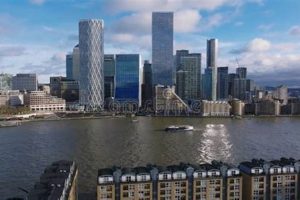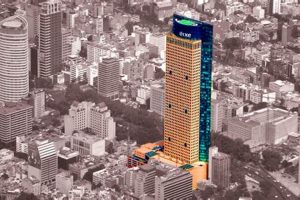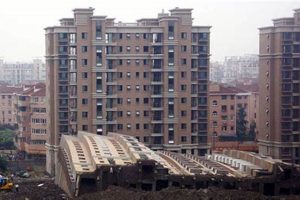When discussing skyscrapers, a common question that arises is “how tall?” This question delves into the realm of building heights, a fascinating aspect of architecture and engineering.
The height of a skyscraper is a crucial factor that influences its design, construction, and overall impact. Taller buildings require more robust structural systems, innovative engineering solutions, and careful consideration of factors such as wind loads and seismic activity. They also present unique challenges in terms of elevator systems, fire safety, and building maintenance.
Beyond their engineering significance, the height of skyscrapers holds symbolic and cultural importance. Tall buildings have often been seen as representations of power, prestige, and economic prosperity. They serve as landmarks, shaping the skylines of cities and becoming iconic symbols of urban centers.
1. Structural Systems
Structural systems play a crucial role in determining the height of a skyscraper. The taller the building, the greater the structural challenges that must be overcome. Structural engineers must design systems that can withstand the gravitational forces acting on the building, as well as lateral loads such as wind and seismic forces.
- Components: Skyscraper structural systems typically consist of a combination of steel frames, concrete cores, and exterior walls. The steel frames provide the primary support for the building’s weight, while the concrete cores provide additional strength and stability. The exterior walls help to distribute wind loads and protect the building from the elements.
- Examples: The Burj Khalifa, the tallest building in the world, utilizes a reinforced concrete core and steel exterior frame. The Taipei 101, another supertall skyscraper, employs a steel frame with a concrete core and outrigger dampers to reduce wind-induced sway.
- Implications: The structural system of a skyscraper has a significant impact on its height. Taller buildings require more robust structural systems to ensure their stability and safety. This can lead to increased construction costs and design complexity.
In conclusion, structural systems are essential for enabling the construction of tall skyscrapers. Engineers must carefully consider the various structural components and their interactions to create buildings that are both safe and efficient.
2. Wind Loads
In the context of skyscrapers, wind loads refer to the forces exerted on a building by wind. These forces can be significant, especially for tall buildings, and must be carefully considered during the design and construction process.
The taller a skyscraper is, the greater the surface area it exposes to the wind. This increased surface area means that there is more potential for wind to exert force on the building. Wind loads can cause buildings to sway, vibrate, and even collapse if they are not properly designed to withstand these forces.
Engineers use a variety of techniques to mitigate the effects of wind loads on skyscrapers. These techniques include:
- Aerodynamic design: Buildings can be designed with aerodynamic shapes that reduce wind resistance.
- Structural reinforcement: Buildings can be reinforced with additional structural elements, such as bracing and shear walls, to increase their resistance to wind loads.
- Damping systems: Damping systems, such as tuned mass dampers, can be installed to reduce the building’s response to wind loads.
Understanding the relationship between wind loads and skyscraper height is essential for ensuring the safety and stability of these structures. Engineers must carefully consider wind loads when designing skyscrapers, and they must use appropriate techniques to mitigate the effects of these forces.
3. Seismic Activity
In regions prone to seismic activity, the height of a skyscraper becomes even more critical. Earthquakes generate powerful forces that can cause buildings to sway, crack, and even collapse. The taller a building is, the more vulnerable it is to these forces.
To ensure the safety of skyscrapers in earthquake-prone areas, engineers must carefully consider seismic activity during the design and construction process. This includes:
- Site selection: Choosing a building site with stable ground conditions is crucial. Avoid areas with known seismic faults or liquefaction potential.
- Structural design: Buildings must be designed to withstand lateral forces caused by earthquakes. This can be achieved through the use of shear walls, bracing, and other structural elements.
- Seismic isolation: Seismic isolation systems can be installed to reduce the transmission of earthquake forces to the building. These systems use base isolators or dampers to absorb and dissipate energy.
Understanding the connection between seismic activity and skyscraper height is essential for ensuring the safety of these structures in earthquake-prone regions. Engineers must carefully consider seismic forces when designing skyscrapers, and they must use appropriate techniques to mitigate the effects of these forces.
4. Elevator Systems
Elevator systems play a crucial role in skyscrapers, directly influencing their height and functionality. As buildings rise higher, efficient and reliable elevator systems become essential for transporting people and goods throughout the structure.
- Vertical Transportation: Elevators provide vertical transportation, enabling occupants to move quickly and conveniently between different floors. In supertall skyscrapers, multiple elevator banks may be required to handle the increased traffic.
- High-Speed Elevators: Skyscrapers often utilize high-speed elevators to reduce travel time. These elevators can reach speeds of up to 10 meters per second, significantly improving accessibility to higher floors.
- Double-Decker Elevators: Double-decker elevators feature two cabins stacked vertically within a single shaft, increasing passenger capacity and reducing wait times.
- Sky Lobbies: In ultra-tall skyscrapers, sky lobbies serve as transfer points for passengers switching between elevators serving different zones or floors. This helps optimize elevator traf
fic and reduces congestion.
Elevator systems are integral to the design and functionality of skyscrapers, enabling efficient vertical transportation and enhancing the overall user experience. As skyscrapers continue to push the boundaries of height, innovative elevator technologies will be required to meet the unique challenges of these towering structures.
5. Fire Safety
In the realm of skyscrapers, fire safety takes on paramount importance as building heights soar and the number of occupants increases. Stringent fire safety measures are essential to protect lives, property, and the integrity of these towering structures.
- Compartmentalization: Skyscrapers are divided into compartments using fire-resistant walls and floors. This compartmentalization prevents the spread of fire and smoke, giving occupants more time to evacuate.
- Sprinkler Systems: Throughout the building, automatic sprinkler systems are installed to quickly suppress fires. These systems detect heat and release water to extinguish flames, reducing the risk of fire spread.
- Smoke Control Systems: Smoke control systems are designed to remove smoke from escape routes and pressurize stairwells to prevent smoke from entering. This helps ensure safe evacuation during a fire.
- Fire Alarm and Detection Systems: Advanced fire alarm and detection systems are installed to alert occupants and emergency responders in the event of a fire. These systems use smoke and heat detectors to trigger alarms and notify the fire department.
These fire safety measures are crucial for skyscrapers, as their height and complexity present unique challenges in containing and extinguishing fires. By implementing these measures, architects, engineers, and building owners work to ensure the safety of occupants and the integrity of these towering structures.
6. Building Maintenance
Building maintenance plays a crucial role in ensuring the safety, functionality, and longevity of skyscrapers. As buildings climb higher, the importance of regular and comprehensive maintenance becomes increasingly evident. The towering height of skyscrapers presents unique challenges that require specialized maintenance strategies and technologies.
One of the primary concerns in skyscraper maintenance is the exterior facade. The height of the building makes it difficult to access and inspect the exterior, and harsh weather conditions can take a toll on the facade materials. Regular cleaning, repairs, and inspections are essential to prevent deterioration, water damage, and potential hazards. Specialized equipment, such as suspended scaffolding and window-washing robots, is often employed to ensure thorough cleaning and maintenance of the exterior.
Another critical aspect of skyscraper maintenance is the mechanical, electrical, and plumbing (MEP) systems. These systems are responsible for the building’s heating, ventilation, air conditioning, lighting, elevators, and other essential functions. Regular maintenance and inspections are crucial to ensure the proper operation of these systems, prevent breakdowns, and maintain a comfortable and safe environment for occupants. Advanced monitoring systems and predictive maintenance techniques are increasingly being used to optimize MEP system performance and reduce downtime.
Furthermore, fire safety systems in skyscrapers require meticulous maintenance and testing. Sprinkler systems, smoke detectors, fire alarms, and emergency lighting must be regularly inspected and maintained to ensure they are in optimal working condition. Fire drills and evacuation procedures are also essential to ensure the safety of occupants in case of an emergency.
Overall, building maintenance is an integral part of the management and operation of skyscrapers. By implementing comprehensive maintenance strategies, building owners and managers can ensure the safety, functionality, and longevity of these towering structures. Regular maintenance not only protects the investment in the building but also contributes to the well-being and productivity of its occupants.
7. Symbolic Importance
The symbolic importance of skyscrapers lies in their ability to convey power, prestige, and economic prosperity. As buildings rise higher, they become iconic landmarks that shape the skylines of cities and represent the ambitions and achievements of their creators.
The height of a skyscraper can symbolize the economic strength and prosperity of a city or nation. For example, the Burj Khalifa in Dubai, the tallest building in the world, is a testament to the city’s rapid growth and economic success. Similarly, the Petronas Towers in Kuala Lumpur represent Malaysia’s economic transformation and its aspirations to become a global player.
Skyscrapers can also symbolize political power and national pride. The Empire State Building in New York City, for instance, became an iconic symbol of American resilience and determination after the 9/11 terrorist attacks. Likewise, the Shanghai Tower in China represents the country’s growing economic and political influence on the world stage.
Understanding the symbolic importance of skyscrapers provides valuable insights into the cultural and economic dynamics of cities and nations. It helps us appreciate the role that architecture plays in shaping our perceptions and aspirations, and how the height of a building can transcend its physical dimensions to become a symbol of human ambition and achievement.
FAQs about Skyscraper Heights
In this section, we address frequently asked questions regarding the heights of skyscrapers, providing informative answers to clarify common concerns and misconceptions.
Question 1: What factors determine the height of a skyscraper?
Answer: Several factors influence the height of a skyscraper, including structural capabilities, wind loads, seismic activity, elevator systems, fire safety regulations, and economic considerations.
Question 2: How do engineers ensure the stability of tall skyscrapers?
Answer: Engineers employ various techniques to ensure stability, such as using robust structural systems, incorporating wind-resistant designs, and implementing seismic dampening mechanisms.
Question 3: What are the challenges associated with constructing extremely tall skyscrapers?
Answer: Extreme height construction presents challenges in material strength, wind resistance, and efficient elevator systems. Additionally, safety concerns during construction and maintenance become increasingly critical.
Question 4: How do skyscrapers contribute to the urban environment?
Answer: Skyscrapers play a significant role in urban development by optimizing land use, fostering vertical communities, and serving as iconic landmarks that define city skylines.
Question 5: What is the significance of height records in skyscraper construction?
Answer: Height records represent architectural advancements, engineering prowess, and economic power, pushing the boundaries of design and construction capabilities.
Question 6: How does sustainability factor into skyscraper design and construction?
Answer: Sustainable skyscrapers incorporate energy-efficient materials, optimize natural light, and employ water conservation systems, aiming to minimize environmental impact while maintaining occupant comfort.
These FAQs provide a comprehensive overview of the various aspects surrounding skyscraper heights, addressing common concerns and highlighting important considerations in the design and construction of these towering structures.
By delving into these questions and answers, we gain a deeper understanding of the complexities and intricacies involved in creating these architectural marvels that shape our cities and skylines.
Tips on Skyscraper Heights
Understanding the various factors influencing skyscraper heights is crucial for architects, engineers, and urban planners involved in the design and construction of these towering structures. Here are a few key tips to consider:
Tip 1: Prioritize Structural Integrity
Ensure the building’s structural system can withstand gravitational forces, wind loads, and seismic activity. Utilize robust materials, advanced engineering techniques, and innovative designs to guarantee stability and safety.Tip 2: Mitigate Wind Effects
Incorporate aerodynamic designs, structural reinforcements, and damping systems to minimize the impact of wind forces. Conduct wind tunnel tests and simulations to optimize the building’s shape and reduce wind-induced sway.Tip 3: Address Seismic Concerns
In earthquake-prone areas, implement seismic isolation systems, shear walls, and bracing to enhance the building’s resistance to lateral forces. Consider the soil conditions and seismic history of the site during the design process.Tip 4: Optimize Elevator Systems
Design efficient elevator systems to handle the vertical transportation needs of high-rise buildings. Utilize high-speed elevators, double-decker elevators, and sky lobbies to improve accessibility and reduce wait times.Tip 5: Enhance Fire Safety Measures
Implement comprehensive fire safety systems, including compartmentalization, sprinkler systems, smoke control systems, and fire alarm detection. Regularly inspect and maintain these systems to ensure optimal functionality and occupant safety.Tip 6: Ensure Regular Maintenance
Establish a thorough maintenance plan that addresses the unique challenges of skyscraper maintenance. Utilize specialized equipment and technologies for facade cleaning, MEP system monitoring, and fire safety inspections to preserve the building’s integrity and longevity.Tip 7: Consider Symbolic Importance
Recognize the symbolic value of skyscraper heights and design buildings that reflect the aspirations and cultural identity of the city or region. Create iconic landmarks that contribute to the urban fabric and evoke a sense of pride and belonging.Tip 8: Embrace Sustainable Design
Incorporate sustainable practices into skyscraper design and construction. Utilize energy-efficient materials, optimize natural light, and implement water conservation systems to minimize environmental impact and promote occupant well-being.By adhering to these tips, architects, engineers, and urban planners can create skyscrapers that are not only structurally sound and safe but also contribute positively to the urban environment and reflect the aspirations of the communities they serve.
Skyscraper Heights
The exploration of “skyscraper how tall” has taken us on a journey through the fascinating world of high-rise architecture. We have examined the intricate relationship between a skyscraper’s height and its structural integrity, wind resistance, seismic stability, elevator systems, fire safety measures, building maintenance, and symbolic importance.
Skyscrapers, with their towering heights, stand as testaments to human ambition and architectural ingenuity. They push the boundaries of engineering and design, reshaping skylines and becoming iconic symbols of cities around the globe. As we continue to strive for new heights, it is essential to approach skyscraper construction with a holistic understanding of the challenges and complexities involved.







